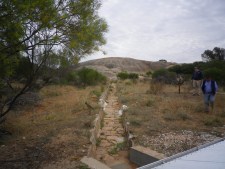Producer: Phil (Dishy) McKenna
Location: Kyancutta
Property Area: 3,642 Ha
Enterprises: Mixed Cereal and Sheep Production.
Cropping area leased 1,821 ha year in year out, Dishy runs 500 Ewes, also trading stock year round.
Annual Rainfall: 320 mm
In 2008 Phil purchased a nearby property, however it did not have access to SA Water pipeline. “There was an old run down water catchment system using a small dwarf wall built around the bottom of a large granite outcrop” said Dishy. The water catchment was built about 100 years ago and was in very poor condition. The granite outcrop was used to capture rain water diverting it into an underground tank. “Access to the nearest mains water was five kilometres away, so I decided to renovate the old catchment,” Dishy said
“I was able to work out that the 9,000 square metre granite outcrop had the potential to catch approximately 3 megalitres of water” said Dishy.
The old water catchment system was in very poor condition. For it to work well, renovation needed to be carefully planned. The original 550,000 litre underground tank leaked, so it had to be cleaned out and replastered. The dwarf walls around the granite outcrop also needed to be repaired.
A fully enclosed shed (15 m x 16 m) was built over the old underground tank to secure the site from people and keep out native animals and stock. “The shed also stopped water loss from evaporation,” said Dishy. The shed roof provided a further 240 m2 catchment area that was also diverted into the underground tank. “As there is no power at the shed, a solar panel was installed to run a mono pump to move water from the underground tank into 80,000 gallon (302,000 litres) header tank,” Dishy said. The header tank is located 150 metres above sea level allowing water to be gravity fed over the property, supplying smaller header tanks and troughs.
The water scheme has been installed in two stages. The 1,416 ha property was divided into two large paddocks and the first stage was to supply water to each paddock. Two troughs with 20,820 litre header tanks were installed approximately 1.5 km apart in the largest paddock (1,011 ha). “I placed Tumby Bay cement troughs on heavy ground in the swales to change the grazing patterns of the sheep. I am slightly understocked and placed the troughs to take the pressure off the sandy rises to reduce soil erosion. I am already starting to see improvement in soil cover,” Dishy said.
In the second stage, Dishy successfully gravity fed the water back to his original farm 10 kilometres away using 32mm pipe.
The home property has 5 paddocks ranging from 170 to 364 hectares. Water is stored in an 80,000 gallon tank (302,000 litres) 100m above sea level with the water being gravity fed over the farm. Each paddock has centrally placed troughs. Water is gravity fed to the troughs from 20,000 litre tanks (with a 32mm riser) installed 10–50 metres away.
The result is that two thirds of his home property is also supplied with water captured from the Granite outcrop catchment system.
Dishy crops year in year out and runs a core mob of 500 ewes. He buys and sells some 1,000 lambs, which he paddock finishes. During the winter months he runs his sheep in paddocks which are serviced by SA water. In late winter/summer he moves all his sheep to paddocks watered from the water catchment. Dishy said “SA water is 150 psi, whilst I run my system at 60 psi, reducing the potential for leaks. The water quality is excellent and there is no calcium build up in the pipe.”

At this stage Dishy has spent approximately $150,000 on getting the water system up and running, which returns approximately 5% on his investment. Dishy estimates that he has saved $10,000 to $15,000 per year. “The time and money saved in chasing water leaks, blown pipes and repairs allows me spend more time on my business” said Dishy
“There have been many benefits from the investment in repairing the old catchment,” said Dishy. “The benefits include being less dependent on mains water, using our natural resources, and reduced water bills. Cleaner water has been a benefit for stock production and cereal spraying.”
“I am very happy with the way the system is working at this stage, but I am aware that some of the catchment dwarf walls still need up-keep and the catchment gutters have to be regularly cleaned,” said Dishy.
Overall Dishy’s water security plan is a very impressive, well thought-out water catchment, using new and existing infrastructure. Dishy said that now he has the infrastructure in place he has the potential to add more troughs and tanks to the system.